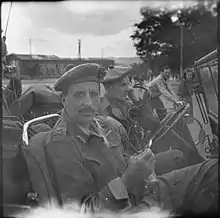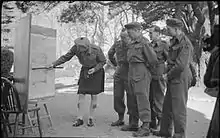Tom Rennie
Major-General Thomas Gordon Rennie CB DSO MBE (3 January 1900 – 24 March 1945) was a British Army officer who commanded the 3rd Infantry Division and later the 51st (Highland) Infantry Division during World War II and was later killed in action during Operation Plunder, the crossing of the River Rhine in March 1945.
Tom Rennie | |
|---|---|
 | |
| Born | 3 January 1900 Foochow, China |
| Died | 24 March 1945 (aged 45) River Rhine, Germany |
| Buried | Reichswald Forest War Cemetery, Germany |
| Allegiance | |
| Service/ | |
| Years of service | 1918−1945 |
| Rank | Major-General |
| Service number | 18139 |
| Unit | Black Watch |
| Commands held | 5th Battalion, Black Watch 154th Infantry Brigade 3rd Infantry Division 51st (Highland) Infantry Division |
| Battles/wars | World War II |
| Awards | Companion of the Order of the Bath Distinguished Service Order Member of the Order of the British Empire |
Military career
Educated at Loretto School and the Royal Military College, Sandhurst, Rennie was commissioned as a second lieutenant into the Black Watch (Royal Highland Regiment) on 16 July 1919.[1][2] Attending the Staff College, Camberley from 1933 to 1934, he saw active service in the Second World War, was taken prisoner at Saint-Valery-en-Caux during the final stages of the Battle of France in June 1940, but then escaped nine days later.[1] He was made Commanding Officer (CO) of the 5th Battalion, Black Watch (Royal Highland Regiment) in 1942, leading the battalion at the Second Battle of El Alamein in October 1942,[3] and then becoming Commander of the 154th Infantry Brigade[1] and leading that formation for the Allied invasion of Sicily in July 1943.[3]

In December 1943 he was appointed General Officer Commanding 3rd Infantry Division in which role he took part in the Normandy landings in June 1944.[1] He was then made General Officer Commanding 51st (Highland) Infantry Division but in March 1945, after crossing the Rhine, he was killed by mortar fire.[1]
He is buried in Reichswald Forest War Cemetery.[4]
References
- Loretto Roll of Honour Archived 28 March 2012 at the Wayback Machine
- "No. 31505". The London Gazette (Supplement). 12 August 1919. p. 10343.
- Exhibition: "They got a huge reception at St Valery" Breakout from Normandy Archived 28 March 2012 at the Wayback Machine
- "Casualty Details: Rennie, Tom Gordon". www.cwgc.org: Commonwealth War Graves Commission. Retrieved 11 October 2011.
Bibliography
External links
| Wikimedia Commons has media related to Thomas Gordon Rennie. |
| Military offices | ||
|---|---|---|
| Preceded by William Ramsden |
GOC 3rd Infantry Division 1943−1944 |
Succeeded by Lashmer Whistler |
| Preceded by Charles Bullen-Smith |
GOC 51st (Highland) Infantry Division 1944−1945 |
Succeeded by Gordon MacMillan |